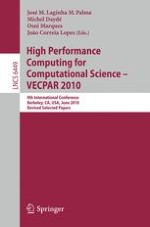2011 | Book
High Performance Computing for Computational Science – VECPAR 2010
9th International conference, Berkeley, CA, USA, June 22-25, 2010, Revised Selected Papers
Editors: José M. Laginha M. Palma, Michel Daydé, Osni Marques, João Correia Lopes
Publisher: Springer Berlin Heidelberg
Book Series : Lecture Notes in Computer Science
